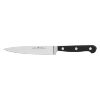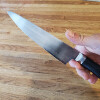A friend gave me two knives to work on. These are kitchen knives with integral bolsters of the kind that go all the way down to the cutting edge of the blade.
Here's an example, in fact, the knives in question are actually this brand. Henckels.

https://www.zwilling.com/us/henckel...enckels-international_cutlery_classic#start=9
The knives are many years old and have been sharpened many times. They have been sharpened so much that the integral bolster began to protrude below the cutting edge of the blade instead of being flush with the blade. This meant that the rear portion of the blade can't be brought into contact with the cutting surface, preventing the proper use of the knife for some purposes.
The owner was unhappy with this situation and wanted me to see if there was some way to remedy the problem. (Actually, the frustration level was such that the knives were given to me as an alternative to throwing them away.)
I was able to grind the bolsters down so that they were slightly above the cutting edge and then when I sharpened the knife, the edge ended up being just about flush with the bottom of the bolster, just as when the knife was new.
Then I touched up the bolsters so they look nice and have roughly the same profile as before the work. Fortunately the bolsters were not as hard as the blade steel and I was able to use a file to reprofile them and clean them up.
It was an interesting challenge, and both knives are now usable again, but I have decided that I do not like this type of integral bolster. I don't see any real advantage to them and dealing with them in the circumstances described above is a pain.
I apologize for not taking before and after photos as that would have made things easier to understand, but I didn't really think about it until I was finished.
Anyway, just something to think about when purchasing kitchen cutlery.
Here's an example, in fact, the knives in question are actually this brand. Henckels.

https://www.zwilling.com/us/henckel...enckels-international_cutlery_classic#start=9
The knives are many years old and have been sharpened many times. They have been sharpened so much that the integral bolster began to protrude below the cutting edge of the blade instead of being flush with the blade. This meant that the rear portion of the blade can't be brought into contact with the cutting surface, preventing the proper use of the knife for some purposes.
The owner was unhappy with this situation and wanted me to see if there was some way to remedy the problem. (Actually, the frustration level was such that the knives were given to me as an alternative to throwing them away.)
I was able to grind the bolsters down so that they were slightly above the cutting edge and then when I sharpened the knife, the edge ended up being just about flush with the bottom of the bolster, just as when the knife was new.
Then I touched up the bolsters so they look nice and have roughly the same profile as before the work. Fortunately the bolsters were not as hard as the blade steel and I was able to use a file to reprofile them and clean them up.
It was an interesting challenge, and both knives are now usable again, but I have decided that I do not like this type of integral bolster. I don't see any real advantage to them and dealing with them in the circumstances described above is a pain.
I apologize for not taking before and after photos as that would have made things easier to understand, but I didn't really think about it until I was finished.
Anyway, just something to think about when purchasing kitchen cutlery.




